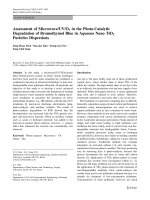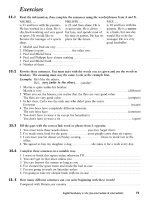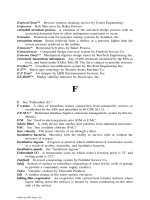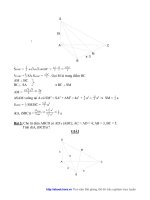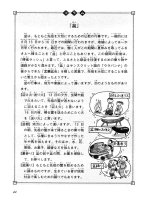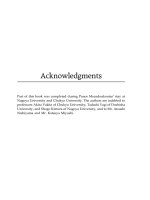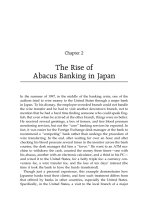The Rise and Fall of Abacus Banking in Japan and China phần 4 ppt
Bạn đang xem bản rút gọn của tài liệu. Xem và tải ngay bản đầy đủ của tài liệu tại đây (192.85 KB, 21 trang )
The Rise of Abacus Banking in Japan 41
securing cooperation in keeping economic objectives going smoothly.’’
54
According to Abegglen, this means that
the government of Japan stands behind the debt position of major Japanese com-
panies, thus both making possible the financing necessary for rapid growth and
ensuring that the government through the power of persuasion will play a cen-
tral role in determining the nature and the direction of that growth.
55
Standing behind the debt of large corporations, the Japanese govern-
ment in essence eliminated both traditional and non-traditional banking
risks for Japanese banks. But government bureaucrats provided another,
perhaps even more effective way of eliminating risks for Japanese
banks—tight financial and banking regulation—which, as stated earlier,
controlled the behavior of bank managers and made risk management
irrelevant altogether.
Specifically, financial regulation eliminated risks for banks by limiting
competition both across banking and securities industries and within the
banking industry. MOF regulation insulates Japanese banks from outside
competition while preventing excessive competition among them. The
MOF ‘‘extended an unqualified guarantee against failure, promising im-
plicitly to use its full armada of powers to keep banks afloat.’’
56
Exchange
rate controls and restrictions on foreign capital flows limited the entry
of foreign banks and securities companies into the Japanese financial
markets, eliminating the exchange rate risks. ‘‘Restrictions on inward and
outward capital flows prevented savers and borrowers from exploiting
foreign capital markets, ensuring that domestic credit restraint was not
frustrated by capital inflows under the fixed exchange rate system.’’
57
The Securities and Exchange Law of 1948, the Japanese version of the
Glass-Steagall Act of 1933, limited competition between traditional bank-
ing and securities, except for the purchase of securities for their own
account. But financial regulation reached beyond industry entry restric-
tions. It strictly defined the types of business and products to be offered
by banks, creating city banks, regional banks, and trust banks and over-
seeing their day-to-day operations. ‘‘In addition to keeping government
control of foreign interest rates and preventing the siren song of market
forces from luring capital offshore, a rigid segmentation of financial in-
stitutions historically worked to keep Japan’s flow of funds in a constant
steady state.’’
58
In some cases, the MOF intervened either alone or with other banks
to rescue a failing bank. According to Ikeo,
42 The Rise and Fall of Abacus Banking in Japan and China
When, in the past, the government recognized a failing bank, it intervened di-
rectly and the bank’s operations were restored. If it proved impossible to restore
the bank using the bank’s own resources the government appealed to other banks
and financial institutions, either for assistance or to absorb the failing institution
into their own organization.
59
Japan’s tight banking regulation replicates a government cartel, a
Gosou-sendan Houshiki, an ‘‘escorted convoy’’ system. MOF ‘‘destroyers’’
protect banks from outsiders and ensure that they are all moved in tan-
dem, without crushing one against the other (see Exhibit 2.9). In plain
economic terms, government regulation has turned the Japanese banking
industry into an oligopoly cartel, where prices are closely controlled.
According to Hartcher,
Prices—in the form of interest rates—were closely controlled by the ministry in
unofficial but binding consultation with the banks. Even after the banks were
legally granted full freedom to decide their own interest rates, they continued to
set them in concert at agreed levels. The banks also worked intimately with the
ministry deciding the level of services they offered customers and even the sal-
aries they paid their staff.
60
To preserve this type of cartel-like system, MOF ‘‘sanctions are imposed
on cartel-breakers by public authorities whose role is to preserve the
integrity of the cartel.’’
61
One way that the MOF keeps banks moving together is through li-
censing (i.e., the requirement that banks must submit any new business
proposal to the MOF for approval). The MOF approves applications for
the establishment of banks, applications for the reductions in bank cap-
ital, the opening and closing of branches, and the merger and liquidation
of existing bank operations. Once the MOF approves a new business for
a bank, it applies it to all banks. The development of jusen is a case in
point. Within a year after their approval, the MOF convinced banks to
enter the market for individual homeowner mortgages, intensifying com-
petition and eliminating market rents for jusen. In this sense, banks can
compete in one way only, through volume (i.e., through growth of the
overall industry), making the pieces of the pie larger by making the pie
larger (see Exhibit 2.10). Thus, ‘‘a clear distinction between innovating
leaders and less innovative followers has been clouded by the Japanese
government through a system of administrative licensing and approvals,
Exhibit 2.9
Gosou-sendan Houshiki
Exhibit 2.10
Bank Assets, Economic Growth, and Gosou-sendan Houshiki
The Rise of Abacus Banking in Japan 45
which has generally retarded innovation in the banking industry as a
whole.’’
62
The MOF further monitors and inspects the day-to-day operations of
banks and asks them to restructure their asset and liability positions as
deemed appropriate. But once again, the MOF monitors bank operations
closely so as to virtually control the behavior of bank managers. For the
sake of the ‘‘protection of depositors,’’ for instance, MOF officers are
allowed to meddle in banks’ day-to-day operations, in essence running
banks, enjoying benefits that could be viewed as outright bribes in other
countries.
Japan’s Ministry of Finance is much more than an office of government. It is a
political, economic, and intellectual force without parallel in the developed
world. It enjoys greater concentration of powers, formal, and informal, than any
comparable body in any other industrialized democracy. In Japan, there is no
institution with more power.
63
The minister may also ask banks at any time to submit reports on their business
and accounts, and can inspect them. He can order a bank to close or compound
its assets in a deposit office, or issue any other orders deemed necessary, should
a bank commit illegal acts or the Minister considers that a deterioration in its
financial condition necessitates such measures to protect depositors.
64
With such vested powers and with little checks and balances by the
other two constitutional powers (the legislative and the judiciary), the
MOF rather than bank managers decided how credit should be allocated,
which has resulted in a rather peculiar relationship between the regu-
lators and the regulated. First, the regulated (banks) cooperate with the
regulators (the MOF) to conceal non-performing assets, as evidenced in
the Daiwa Bank’s New York trading losses. Second, the fear of MOF
inspections, for instance, has led Japanese banks to devote substantial
resources to enjoying good relations with the MOF (this includes the
designation of a bank officer, MOF-tan, to entertain MOF inspectors, so
the bank can obtain leads about forthcoming inspections).
Third, good relations between banks and the MOF also include the
very well-known practice of amakundori, or ‘‘descent from heaven,’’
where banks offer high-paid positions to former MOF officers. In this
way, banks end up managed by former MOF executives, imbued in bu-
reaucracy and immersed in law and government rather than in econom-
ics or management. This means that former MOF bureaucrats make bad
46 The Rise and Fall of Abacus Banking in Japan and China
bank managers. Banks run by former MOF bureaucrats have lower ROEs
as compared to banks run by non-MOF bureaucrats. As Hartcher ob-
serves: ‘‘The independent banks were on average 4.6 percent more prof-
itable than those run by former officials of the central bank, and 7.4
percent more profitable than those headed by former officials of Oku-
rasho.’’
65
Hartcher attributes this to a lack of expertise.
The Okurasho wants its staff to understand economics but not to be possessed
by it. It wants officials who see economics but not to be possessed by it. It wants
officials who see economics as one set of considerations and legal principles
rather than those of economics as paramount.
66
The Economist has another explanation:
Technological innovation has left officials trained as generalists unable to grasp
many of the issues that they now have to confront. Bureaucratic shortcomings
occur in all countries, but in Japan officials assume wide-ranging powers for the
kind of detailed policymaking that is done by expert groups in countries else-
where.
67
Fourth, under these circumstances, according to Ikeo,
Bank managers cannot be completely responsible for their actions. When a bank
runs into a difficult situation, it becomes nearly impossible to determine whether
the situation is the result of bad decision-making on the part of the bank’s man-
agement or improper guidance on the part of bank regulators.
68
In addition, banks had little incentive to assume risks in developing new
products. As Ikeo puts it, ‘‘The convoy system of administrative guid-
ance is incompatible with innovation simply because innovation implies
cartel destruction.’’
69
In short, Japanese banks have neither the freedom nor the expertise to
function as true for-profit banking institutions. Though by and large pri-
vately owned, the Japanese banking sector resembles more the banking
of a centrally planned economy rather than that of the market economies,
most notably the United States.
70
Credit is rationed under government
guidance and the close ties between borrowers and lenders rather than
under a credit risk management regime.
At this point, one should raise two questions. First, if in a sense tight
government regulation creates an economic environment similar to that
of centrally planned economies, how did a number of Japanese manu-
The Rise of Abacus Banking in Japan 47
facturing industries succeed to compete in world markets? Second, why
have Japan’s trade partners, especially the United States, tolerated such
practices?
In answering the first question, economists divide the Japanese econ-
omy into two sectors—a modern, export-oriented sector and a backward
domestic sector, arguing that it is the modern, export-oriented sector that
succeeded in world markets.
71
Economists further argue that this sector
succeeded not because of but in spite of government regulation. Accord-
ing to Porter,
In a number of industries, the government erroneously attempted to limit the
number of Japanese competitors. Examples include steel, autos, machine tools,
and computers. The unwillingness of Japanese companies to abide by govern-
ment consolidation plans proved to be a blessing, and intense domestic rivalry
contributed to international success. In the 1980s, MITI has become more aware
of the importance of domestic rivalry, though the tendency to limit competition
is a continuing problem.
72
While the zaibatsu structure concentrated economic power in prewar Japan, its
breakup by the allies unleashed a level of competition that is unmatched in any
nation. Virtually every significant industry in which Japan has achieved an in-
ternational competitive advantage is populated by several and often a dozen or
more competitors.
73
In spite of protectionism, rivalry and competition were maintained in
many industries, especially those that had been successful in the world
markets. The number of competitors ranges from 4 in motorcycles and
musical instruments to 25 in audio equipment and 112 in machine tools.
Thus, unlike European industrial policies, which use protectionism to
restrict competition, Japan’s industrial policies use protectionism to
strengthen competition, in targeted sectors.
The answer to the second question, that is, why Japan’s trade partners,
especially the United States, have tolerated such practices, is twofold.
First, as argued elsewhere, counting on Japan as an indispensable ally in
containing Soviet and Chinese expansion in the Asian-Pacific region, the
United States awarded Japan a generous ‘‘dowry’’
74
—GATT/IMF mem-
bership
75
without substantial reciprocation from Japan. Japanese banks
could have it both ways, open markets abroad and a sanctuary home,
which could explain the rapid overseas expansion of Japanese banks in
the late 1970s and the 1980s, which will be addressed in the next chapter.
48 The Rise and Fall of Abacus Banking in Japan and China
Second, a substantial part of Japan’s banking liquid assets was invested
in dollars, allowing the United States to enjoy its own seigniorage (i.e.,
the United States enjoyed Japanese goods simply by printing money).
To sum up, faced with a fast-growing economy, rising savings and
asset values, and with the BOJ prepared to provide sufficient liquidity,
Japanese banks had little to be concerned with traditional banking risks
in the extended high-growth era. In addition, in this era, traditional
banking risks were irrelevant in bank management altogether. Partici-
pating in lending consortia arranged by main banks rather than selecting
borrowers individually, banks diversified credit risks. As members of
keiretsu groups and within the Gosou-sendan Houshiki (the ‘‘escorted con-
voy’’ system), bank managers had little freedom to manage bank port-
folios in a ‘‘rational’’ way (i.e., in a way that allocated credit according
to the principles of profit maximization and credit risk management).
Instead, bank managers allotted credit to corporate clients according to
keiretsu relations and government guidance, a strategy that eventually
ran into several snags as soon as the Gosou-sendan Houshiki began to
disband and the economy began to slow down.
NOTES
1. Indeed, underperforming U.S. corporations are subject to corporate take-
overs and stockholder class action suits that may eventually cost managers their
jobs.
2. Individual stockholders have no power in Japan. Stockholder meetings are
held in name only, and hostile takeovers and class action suits are still unknown
in the Japanese corporate world.
3. Strictly speaking, the high growth era ends in 1973 with the first oil shock.
But since the Japanese economy resumed its growth two years later, until 1989,
we take that as the year the high growth era ended.
4. Tsuru (1993).
5. Kunio (1979).
6. See Fagerberg (1994), table 1. See also Yanagihara (1994).
7. M. Porter, The Competitive Advantage of Nations (New York: The Free Press,
1990), p. 280.
8. The Korean War had a strong positive impact on the cotton and steel in-
dustries.
9. OECD, Economic Outlook (Paris: OECD), various issues.
10. Fagerberg (1994).
11. OECD, Economic Outlook, various issues.
12. Morita (1992).
The Rise of Abacus Banking in Japan 49
13. ‘‘From Miracle to Mid-Life Crisis’’ (1993).
14. Japan’s high-growth era further coincided with favorable demographics
that gave another boost to savings, a host of generation cohorts that reached
middle age in the 1970s and the 1980s, which in turn boosted savings, adding
more fuel to the steady flow of deposit funds into the banking system. Indeed,
for decades, Japan had one of the highest savings rates in the industrial world,
which in the absence of accessible financial markets ends up in the hands of
bankers and in loans to Japanese corporations.
15. OECD (1993), p. 22.
16. Ibid.
17. Burstein (1988), pp. 36–37.
18. ‘‘Interest rate spread’’ is the difference between deposit interest rates and
lending interest rates.
19. Burstein (1988), p. 150.
20. Cauly and Zimmer, ‘‘Credit Rating in Large Banks,’’ Quarterly Review of
the Federal Reserve Bank of New York (Summer 1989), pp. 897–922.
21. Shikano (1998), p. 9.
22. OECD, Economic Outlook (Paris: OECD, 1990/1991), p. 78.
23. Suzuki (1987), p. 22.
24. Adams and Hoshii (1972), p. 127.
25. Lazonick and O’Sullivan (1997), p. 120.
26. Pressnell (1973), p. 132.
27. Net rate of return equal to rate of return minus long-term interest rates.
For details, see OECD (1996), p. 18.
28. OECD (1995), p. 8.
29. OECD (1994b), p. 85.
30. For a detailed discussion, see OECD (1994b), section IV.
31. OECD Economic Outlook (1990/1991), p. 77.
32. C. Wood, The End of Japan Incorporated (New York: Simon and Schuster,
1994), p. 119.
33. N. Weinberg, ‘‘Opiate of the Masses,’’ Forbes, November 16, 1998, p. 202.
34. This requirement can be traced back to the late 1920s, but it was gradually
abandoned in the early 1980s.
35. Suzuki (1987), p. 43.
36. In this sense, Japan’s banking system is similar to that of Germany’s, where
banks are allowed to hold equity positions and are active in corporate gover-
nance.
37. Lazonick and O’Sullivan (1997), p. 125.
38. ‘‘Stock Sales Cut into Cross-Holdings,’’ Nikkei Weekly, January 11, 1997 (ed-
itorial), p. 11.
39. OECD, Economic Surveys (US) (Paris: OECD, 1996), p. 127.
40. For details, see Mourdoukoutas (1993), ch. 3.
41. Unable to draw direct financing, companies had to appeal to the banks,
50 The Rise and Fall of Abacus Banking in Japan and China
which played the role of both corporate creditors and stockholders. They provide
for loans and have a substantial ownership in corporations; each bank is allowed
to own up to 5 percent of the stock of a particular corporation. This way, a large
part of the stock of a corporation may be in the hands of just a few banks.
According to a report by the National Conference of Stock Exchanges in 1986,
city and trust banks accounted for 18.9 percent of all stocks publicly held in
Japan.
42. Y. Noguchi, ‘‘Wartime System Still Has Impact on Economy,’’ Nikkei
Weekly, January 16, 1995.
43. Ibid., p. 80.
44. Shikano (1998), p. 83.
45. Ibid., p. 81.
46. R. Brenner, ‘‘The Economics of Global Turbulance,’’ New Left Review, No.
229 (May–June 1998).
47. Pressnell (1973), p. 167.
48. Rosenbluth (1989), p. 112.
49. OECD (1995), p. 58.
50. Shikano (1998), p. 87.
51. H. Patrick and H. Rosovsky (eds.), Asia’s New Giant: How the Japanese Econ-
omy Works (Washington, DC: Brookings Institution, 1976), p. 487.
52. Adams and Hoshii (1972), p. 91.
53. Flamm (1991).
54. Kunio (1979), p. 25.
55. J. Abegglen, Business Strategies for Japan (Tokyo: Sophia University, 1970),
p. 5.
56. Hartcher (1998), p. 136.
57. OECD, Economic Outlook (1990/1991), p. 78.
58. Burstein (1988), p. 118.
59. Ikeo (1999), p. 59.
60. Hartcher (1998), p. 136.
61. Ibid., p. 57.
62. Ibid., p. 57.
63. Hartcher (1998), p. 2.
64. Pressnell (1973), p. 198.
65. Hartcher (1998), p. 41.
66. Ibid., p. 16.
67. ‘‘The Japan Puzzle’’ (1998), p. 23.
68. Ikeo (1999), p. 59.
69. Ibid., p. 57.
70. It comes as no surprise, therefore, that when it comes to regulation, Japan
ranks 35th, even behind Russia, with 30 percent of its economy controlled by
bureaucracy, compared to 7 percent in the United States. For further discussion,
see ‘‘The Japan Puzzle’’ (1998), p. 23.
The Rise of Abacus Banking in Japan 51
71. See Mourdoukoutas (1993).
72. Porter (1990), p. 414.
73. Ibid., p. 424.
74. For details, see Arayama and Mourdoukoutas (1999).
75. General Agreement on Tariffs and Trade/International Monetary Fund.
Chapter 3
The Fall of
Abacus Banking in Japan
Cyclical factors and the collapse of the ‘‘bubble’’ economy have
played a major role in the current economic situation, but extensive
structural changes to Japan’s economy, including the hollowing out
of domestic industries, internal and external pricing disparities, di-
minished entrepreneurship in pioneering new sectors, and stagnant
technological development, should also be noted.
—Ryutaro Hashimoto, Former Minister of
International Trade and Industry
1
In the 19th century, under pressure from the United States and other
countries to end her national seclusion, Japan totally rebuilt her po-
litical, social and economic systems. After World War II, Japan again
transformed herself dramatically. Now our country is working to
achieve a metamorphosis. The force of global competition leaves us
little time to accomplish this task.
—Shoichiro Toyoda, Former CEO,
Toyota Motor Company
2
Few countries have been lucky in their bid for industrialization, and
Japan is one of them. In the last quarter of the nineteenth century, the
silkworm disease in Europe provided the country with the opportunity
to expand her silk exports and textile industries, earning the proceeds
54 The Rise and Fall of Abacus Banking in Japan and China
for the imports of much-needed capital goods. In addition, her victory
in the Sino-Japanese war and the Shimonoseki Treaty provided Japanese
companies with access to China’s economic resource and product mar-
kets (especially in the market for silk-yarn, a raw material in the textile
industry) and a new colony, Taiwan. Through inexpensive yearn imports
from China and technology from Europe, Japan managed to transform
herself from an exporter of low-value-added agricultural products to
high-value-added manufacturing products, eventually challenging Eu-
rope and the United States.
In the mid-twentieth century, as an indispensable U.S. ally against the
Soviet expansion in Southeast Asia, Japan was rewarded unconditional
access to the newly established GATT/IMF regime. Japanese companies
could take advantage of an expanding world market without opening
her markets to domestic and foreign competition. Once again, through
technology imports and exports of manufacturing goods, Japan managed
to transform herself from an exporter of labor-intensive products to an
exporter of capital intensive products and eventually to an exporter of
technology-intensive products.
But as has been the case in the past, Japan’s export-led industrializa-
tion created tensions with her trade partners, especially the United
States. By the 1980s, a soaring trade surplus, aggressive acquisition of
U.S. assets, and a growing economic presence in Asia created friction
between the two counties. Beginning with President Carter and contin-
uing with President Reagan, America demanded that Japan stimulate her
economy and open her markets to foreign products and competition,
especially as it became obvious that the Soviet Union was at the verge
of collapse and that the United States no longer needed Japan to fight
communism in Asia.
Responding to the United States’ demands in the early 1980s, Japan
eliminated a number of trade and non-trade barriers, especially in in-
dustries where domestic corporations had already established a compet-
itive advantage. As part of the 1985 Plaza Accord, for instance, Japan
eased up on her monetary policy, lifted tariff and non-tariff trade barriers
and government regulations in controversial industries, and allowed the
yen to appreciate considerably against the dollar, measures that had a
pervasive impact on the country’s economy, most notably on the banking
industry.
Monetary easing, for instance, created hyperliquidity, which found its
way into real estate and equity markets, prompting large corporations
to substitute bank financing with debt equity financing. In the meantime,
The Fall of Abacus Banking in Japan 55
the lifting of tariff and non-tariff trade barriers and government dereg-
ulation intensified both domestic and foreign competition. The introduc-
tion of money market and CD accounts in 1985 intensified competition
between banks and mutual fund companies, raising deposit interest
rates. The switching of large corporations (traditionally the largest bank
borrowers) from debt to equity financing and rising deposit rates deliv-
ered a double blow to Japan’s banking system and the abacus strategy:
it narrowed the already thin margin between lending and deposit rates,
reducing the volume of lending to corporate clients at the same time.
This was particularly true during the bubble years, when the interest
rate spread turned negative, eliminating one condition of abacus bank-
ing.
By the late 1980s, the continuing efforts of Japanese policy makers to
address the country’s trade surplus and to avoid a full-scale trade war
with the United States created a new problem, a rise in the cost of living
and an erosion in the country’s competitive advantage. The rise in real
estate prices, for instance, made household and business shelter less af-
fordable. Rising wages and a strong yen priced a number of Japanese
products off the world market, prompting the country’s major corpora-
tions to relocate production offshore; an aging population began to take
its toll on labor supply, savings, and government financing.
To address these problems, Japanese policy makers reversed some of
their earlier policies and accelerated others. In 1990, for instance, to deal
with runaway real estate and equity markets and to curtail rising labor
costs, the BOJ tightened up the money supply. Yielding to foreign and
domestic pressures, Japan continued to deregulate domestic industries.
To address the impact of an aging population on government finances,
policy makers raised taxes twice, in 1993 and in 1996. In the meantime,
the government continued to disband the ‘‘escorted convoy’’ system of
regulation, exposing banks to both external and internal competition.
This new policy shift produced the final blow to the abacus strategy.
With the tightening of both monetary and fiscal policy, economic growth,
corporate profits, and savings and asset values declined. Faced with slow
growth, less regulation, more competition, and declining asset prices,
Japanese banks could no longer survive and prosper merely through
seigniorage income. Instead, they had to search for new sources of in-
come in new, less predictable businesses, a prospect that set the stage
for the decline and fall of abacus banking.
Arguing this proposition, this chapter discusses how international and
domestic pressures prompted Japan to abandon the high-growth, export-
56 The Rise and Fall of Abacus Banking in Japan and China
oriented policies of the Yoshida Doctrine for a new, moderate-growth
policy that emphasized consumption and symbiosis with trade partners.
This chapter further elaborates on how such a policy shift set the Japa-
nese economy on a roller coaster, known as the bubble economy, and its
burst, a roller coaster that led to the decline and fall of abacus banking.
As discussed earlier, for decades the United States has been tolerant
(and even accommodating) regarding Japan’s efforts to expand exports
without opening domestic markets to imports and with good reason.
First, due to her geographic position, Japan was an indispensable mili-
tary ally against the Soviet Union and China, especially during the Ko-
rean War. Second, Japan’s economic development through participation
in the newly established GATT/IMF regime was a test case, a demon-
stration to the rest of Asia and the world that a market system was still
a better alternative than communism. Third, with an industry destroyed
by the war, the Japanese economy was more of a small, poor partner
and less of a large, formidable competitor to the U.S. economy. Fourth,
with low per-capita income, high unemployment rates, and a different
culture, the domestic Japanese consumer market was too small and too
complicated for U.S. corporations.
Japan’s special trade arrangements with the United States and the pol-
icies that supported and reinforced them created a dual economy—a
modern sector and a backward sector.
3
While the modern sector was
little regulated and open to domestic and foreign competitors, the back-
ward sector was extensively regulated and insulated from domestic and
foreign competition. Construction, for instance, is 100 percent regulated,
and so are financial services, electric gas, and mining; some industries,
such as railroads and tobacco, remained government-owned monopolies.
Japan’s economic dualism in turn created a dual friction, one against
her trade partners and another among her citizens. Friction between Ja-
pan and her trade partners was centered in three areas. The first was
friction over the country’s trade and current account surpluses with the
United States, which soared from $4 billion and $2 billion respectively
in 1970 to $24.3 billion and $16.5 billion respectively by 1979.
[Japan] must also recognize that the present structure of US/Japan economic
relations puts US firms at a disadvantage and imposes burdens on the US econ-
omy and on the US citizens. The United States cannot accept this indefinitely
and will need to respond to prevent harm of its citizens.
4
The second was friction over the country’s aggressive and conspicuous
acquisition of highly visible American assets, which the American public
The Fall of Abacus Banking in Japan 57
found unacceptable. When the Mitsubishi Estate purchased a stake in
Rockefeller Center, for instance, major American TV networks intro-
duced the news with images from the bombing of Pearl Harbor. When
Fujistu attempted to buy Fairchild Semiconductors in 1987, the U.S. gov-
ernment intervened, and the deal was dropped. In 1989, Congress ex-
tended the Exon-Florio amendment that gave the government the power
to scrutinize foreign takeovers for national security.
The third was friction over the country’s aggressive expansion to
Southeast Asia, the world’s fastest-growing region at that time.
Friction between Japan and the United States eventually led to several
rounds of negotiations, beginning with the Nixon administration over
the dumping of textile products in the U.S. market and the growing trade
imbalance between the two countries. Negotiations reached a culmina-
tion during the 1985 Plaza Accord, which led to Japan’s monetary easing
and currency appreciation. Between 1985 and 1989, the BOJ cut the of-
ficial discount rate five times, from 5.5 percent to 2.5 percent, and al-
lowed the yen to appreciate from 0.004 dollar to the yen to 0.007 dollar
to the yen (see Exhibit 3.1). The Plaza Accord also included a number of
measures for the opening of a controversial sector—the financial sector—
to domestic and foreign competition.
• March 1985: Large-denomination money market accounts and certificates of
deposit become available; Euro-yen lending to non-Japanese residents (lending
extended by non-resident banks and foreign branches of Japanese banks) be-
gins.
• April 1985: Yen bankers’ acceptance market is inaugurated, decision is made
to allow foreign banks to enter trust banking business.
• October 1985: Interest rates on large deposits are liberalized; bond futures mar-
kets are established.
• June 1986: Foreign banks are authorized to issue European bonds.
• December 1986: Tokyo offshore market opens.
• November 1987: Domestic commercial paper market opens; Euro-yen commer-
cial paper is launched.
• October 1988: Ceiling on share of foreign banks and securities companies as
underwriters of government bonds is raised.
• January 1989: New prime rates for short-term loans reflecting market rates are
introduced.
• June 1989: Small-unit money market certificates are introduced; Tokyo Finan-
cial Futures Exchange opens; Euro-yen lending to Japanese residents begins.
Exhibit 3.1
Exchange Rate (1981–1996)
Source: Statistics Bureau, Japan Statistical Association (various years).
The Fall of Abacus Banking in Japan 59
Efforts to implement these measures had a contradictory impact on
the country’s banking industry. On the one side, monetary easing and
the hyperliquidity that it created accelerated economic growth and asset
inflation, strengthening some of the conditions of abacus banking. The
GDP, for instance, grew from just below 6 percent in 1986 to over 6
percent by 1988. As reflected in the benchmark Nikkei Index, stock prices
rose by 160 percent, from around 14,000 in 1985 to close to 40,000 by
1989. Over the same period, land prices in the Tokyo area more than
doubled.
On the other side, hyperliquidity, the rising of equity prices, and a
stronger dollar prompted large corporations to issue equity and Euro-
bonds instead of borrowing from banks, weakening another condition
of abacus banking. Equity offerings increased from 69 in 1986 to 825 by
1990. During the same period, corporate bank borrowing dropped from
21,661 billion yen to 20,889 billion yen.
5
To make things worse for banks,
robust economic growth further improved corporate cash flow and al-
lowed large companies to finance their expansion internally. Internal fi-
nancing increased from 13.8 percent of the overall finance in 1975 to 22.8
percent in 1985 and 26.2 percent in 1989. In the meantime, bank borrow-
ing fell from 43 percent of the total in 1975 to 31.3 percent by 1989 (see
Exhibit 3.2).
With large corporations shifting from bank lending to equity and bond
offerings, Japanese banks had to shift their lending from the low-risk
large corporate clients to the high-risk small and medium corporations.
Indeed, bank borrowing of medium-sized firms increased from 46.5 per-
cent of the total in 1975 to 49.5 percent in 1989, while the corresponding
figure for small-sized corporations increased from 43.7 percent to 53.6
percent (see Exhibit 3.2).
But what weakened abacus banking the most was financial deregula-
tion, such as the introduction of CDs and other money market instru-
ments, and the liberalization of interest rates on large deposits, which
intensified competition between banks and mutual fund corporations,
raising interest rate deposits and turning the interest rate spread nega-
tive, especially in the period 1987–1990 (see Exhibit 3.3). Competition
between banks and non-banks further intensified by raising the ceiling
on foreign bank participation in government bond underwriting, the in-
troduction of small-unit money market certificates, and the opening of
the Tokyo Financial Futures Exchange.
In short, Japan’s efforts to open her markets to foreign products and
competition and reduce her trade surplus had a double negative impact
60 The Rise and Fall of Abacus Banking in Japan and China
Exhibit 3.2
Financing Ratio of Non-financing Firms (percent, 1975–1989)
Source: OECD (1990/1991), p. 77.
on banks—it lured corporate customers away to equity markets and
turned the interest rate spread negative, eliminating two conditions of
abacus banking. But as long as the other conditions of abacus banking
were in effect (i.e., as long as the economy continued to grow and asset
prices to climb, and as long as other government regulations remained
intact) abacus banking continued to thrive, but not for very long.
By the late 1980s, Japan’s robust economic growth and asset inflation
increased the cost of living, especially the extraordinarily high cost of
housing, turning Japan into a rich country with poor consumers. In 1991,
the size of the average Japanese residence was 881 square feet, compared
to 1,645 square feet in the United States, and only 10.3 percent of Japa-
nese homes had central heating and 45.4 percent had flush toilets
6
(the
corresponding figures for the United States were 85 percent and 99.8
percent). With such a high cost of living, Japanese people were forced
to work long hours, 20–30 percent more than their American and Eu-
ropean counterparts. These statistics place Japan closer to less developed
rather than to most developed nations:
Exhibit 3.3
Interest Rate Spread (1980–1996)
Source: Statistics Bureau, Japan Statistical Association (various years).

